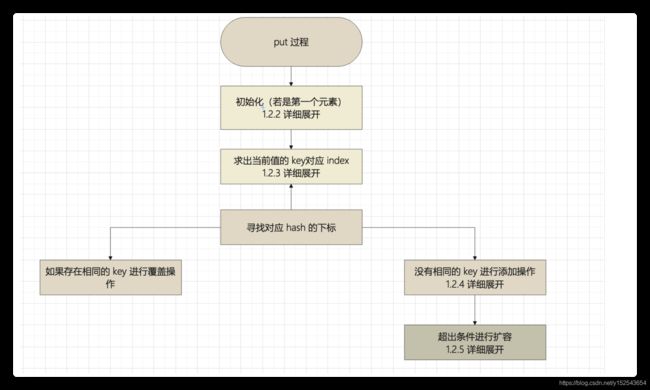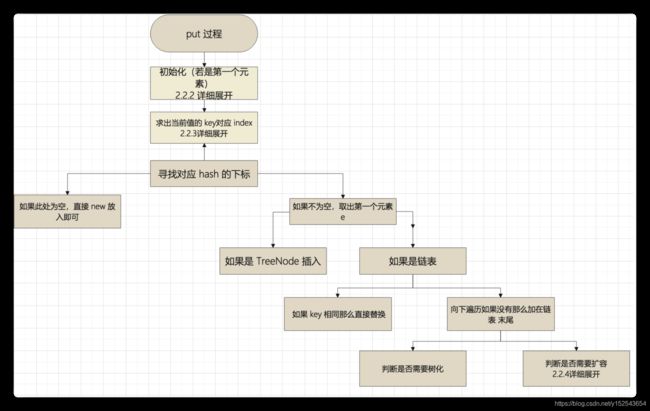吊打面试官系列之 hashmap(面向面试吐血整理)
hashmap复习笔记(面向面试吐血整理)
本文结合优秀博客,jdk 源码,在源码上进行逐行注释,全面整体分析 hashmap1.7,1.8,以及ConcurrentHashMap 1.7,1.8,给出其代码的框图已经整体的代码流程总结,在最后还会结合大厂真实面试题进行总结,对比1.7,1.8版本的区别,一文打通容器,秒杀面试官,总体目录如下
文章目录
- 1. java7 hashmap
-
- 1.1 基本属性以及整体概括
- 1.2 put 过程分析
-
- 1.2.1 put 过程大致流程图
- 1.2.2 初始化过程
- 1.2.3 计算 key 对应 index
- 1.2.4 添加 节点到链表中
- 1.2.5 数组扩容
- 1.3 get 过程
- 2. java8 hashmap
-
- 2.1基本属性以及整体概括
- 2.2 put 过程分析
-
- 2.2.1 put 大致流程图
- 2.2.2 初始化过程
- 2.2.3 计算key 对应的 hash 值以及索引 index
- 2.2.4 数组扩容 resize 方法
- 2.3 get方法分析
- 3. hashmap 面试题总结
-
- 3.1 底层原理和结构 ?
- 3.2 put 过程?
- 3.3 hash 函数是如何实现的?
- 3.4 为什么hashmap 中的& 位必须是(length - 1)(奇数)?
- 3.5 什么是 hash 冲突,如何解决 hash 冲突?
- 3.6 hashmap 线程安全性问题?如何解决?
- 3.7 hashmap 底层红黑树五大特征是什么?
- 3.8 红黑树和 AVL(平衡二叉查找树)比较
- 3.9 Hashmap,LinkedHashMap,TreeMap 的区别
- 3.10 HashMap扩容(resize)的优化是否会重复算 hash
1. java7 hashmap
1.1 基本属性以及整体概括
- 1.7hashmap 是链表 + 数组的形式,里面是一个 Entry
- capacity:始终为2^n,扩容后为当前数组2倍
- loadFactor:0.75
- threshold:扩容的阈值,等于 capacity * loadFactor
1.2 put 过程分析
public V put(K key, V value) {
// 当插入第一个元素的时候,需要先初始化数组大小
if (table == EMPTY_TABLE) {
inflateTable(threshold);
}
// 如果 key 为 null,感兴趣的可以往里看,最终会将这个 entry 放到 table[0] 中
if (key == null)
return putForNullKey(value);
// 1. 求 key 的 hash 值
int hash = hash(key);
// 2. 找到对应的数组下标
int i = indexFor(hash, table.length);
// 3. 遍历一下对应下标处的链表,看是否有重复的 key 已经存在,
// 如果有,直接覆盖,put 方法返回旧值就结束了
for (Entry<K,V> e = table[i]; e != null; e = e.next) {
Object k;
if (e.hash == hash && ((k = e.key) == key || key.equals(k))) {
V oldValue = e.value;
e.value = value;
e.recordAccess(this);
return oldValue;
}
}
modCount++;
// 4. 不存在重复的 key,将此 entry 添加到链表中,细节后面说
addEntry(hash, key, value, i);
return null;
}
1.2.1 put 过程大致流程图
面试的整体思路如上
1.2.2 初始化过程
private void inflateTable(int toSize) {
// 保证数组大小一定是 2 的 n 次方。
// 比如这样初始化:new HashMap(20),那么处理成初始数组大小是 32
int capacity = roundUpToPowerOf2(toSize);
// 计算扩容阈值:capacity * loadFactor
threshold = (int) Math.min(capacity * loadFactor, MAXIMUM_CAPACITY + 1);
// 算是初始化数组吧
table = new Entry[capacity];
initHashSeedAsNeeded(capacity); //ignore
}
答题思路:初始化保证数组是大于当前数值的一个2^n的一个数值,例如 15 -> 16
1.2.3 计算 key 对应 index
static int indexFor(int hash, int length) {
// assert Integer.bitCount(length) == 1 : "length must be a non-zero power of 2";
return hash & (length-1);
}
答题思路 : 简单说就是取 hash 值的低 n 位。也是为什么数组长度必须是 2 的幂次的原因
1.2.4 添加 节点到链表中
void addEntry(int hash, K key, V value, int bucketIndex) {
// 如果当前 HashMap 大小已经达到了阈值,并且新值要插入的数组位置已经有元素了,那么要扩容
if ((size >= threshold) && (null != table[bucketIndex])) {
// 扩容,后面会介绍一下
resize(2 * table.length);
// 扩容以后,重新计算 hash 值
hash = (null != key) ? hash(key) : 0;
// 重新计算扩容后的新的下标
bucketIndex = indexFor(hash, table.length);
}
// 往下看
createEntry(hash, key, value, bucketIndex);
}
// 这个很简单,其实就是将新值放到链表的表头,然后 size++
void createEntry(int hash, K key, V value, int bucketIndex) {
Entry<K,V> e = table[bucketIndex];
table[bucketIndex] = new Entry<>(hash, key, value, e);
size++;
}
答题思路 : 注意是头插法,扩容在下面主要介绍
1.2.5 数组扩容
void addEntry(int hash, K key, V value, int bucketIndex) {
// 如果当前 HashMap 大小已经达到了阈值,并且新值要插入的数组位置已经有元素了,那么要扩容
if ((size >= threshold) && (null != table[bucketIndex])) {
// 扩容,后面会介绍一下
resize(2 * table.length);
// 扩容以后,重新计算 hash 值
hash = (null != key) ? hash(key) : 0;
// 重新计算扩容后的新的下标
bucketIndex = indexFor(hash, table.length);
}
// 往下看
createEntry(hash, key, value, bucketIndex);
}
void resize(int newCapacity) {
Entry[] oldTable = table;
int oldCapacity = oldTable.length;
if (oldCapacity == MAXIMUM_CAPACITY) {
threshold = Integer.MAX_VALUE;
return;
}
// 新的数组
Entry[] newTable = new Entry[newCapacity];
// 将原来数组中的值迁移到新的更大的数组中
transfer(newTable, initHashSeedAsNeeded(newCapacity));
table = newTable;
threshold = (int)Math.min(newCapacity * loadFactor, MAXIMUM_CAPACITY + 1);
}
答题思路:
-
扩容条件:如果当前的 size 已经达到了阈值,并且要插入的数组位置上已经有元素,扩容2倍
-
迁移过程中,会将原来 table[i] 中的链表的所有节点,分拆到新的数组的 newTable[i] 和 newTable[i + oldLength] 位置上。如原来数组长度是 16,那么扩容后,原来 table[0] 处的链表中的所有元素会被分配到新数组中 newTable[0] 和 newTable[16] 这两个位置。代码比较简单,这里就不展开了。仍然使用头插法
1.3 get 过程
public V get(Object key) {
// 之前说过,key 为 null 的话,会被放到 table[0],所以只要遍历下 table[0] 处的链表就可以了
if (key == null)
return getForNullKey();
//
Entry<K,V> entry = getEntry(key);
return null == entry ? null : entry.getValue();
}
final Entry<K,V> getEntry(Object key) {
if (size == 0) {
return null;
}
int hash = (key == null) ? 0 : hash(key);
// 确定数组下标,然后从头开始遍历链表,直到找到为止
for (Entry<K,V> e = table[indexFor(hash, table.length)];
e != null;
e = e.next) {
Object k;
if (e.hash == hash &&
((k = e.key) == key || (key != null && key.equals(k))))
return e;
}
return null;
}
- 根据 key 计算 hash 值。
- 找到相应的数组下标:hash & (length - 1)。
- 遍历该数组位置处的链表,直到找到相等(==或equals)的 key
2. java8 hashmap
2.1基本属性以及整体概括
java8 对 HashMap 进行了一些修改,最大的不同就是利用了红黑树,所以其由 数组+链表+红黑树 组成。
- DEFAULT_INITIAL_CAPACITY 默认容量:16
- DEFAULT_LOAD_FACTOR 扩容因子 0.75
- TREEIFY_THRESHOLD 链表转换为二叉树的阈值 8
- MIN_TREEIFY_CAPACITY 树化的 table 的最小值 64 两个条件都要满足
- UNTREEIFY_THRESHOLD 树转链表的阈值小于等于6
2.2 put 过程分析
final V putVal(int hash, K key, V value, boolean onlyIfAbsent,
boolean evict) {
// tab表示当前hashmap的table
// p表示table的元素
// n表示散列表的长度
// i表示路由寻址结果
Node<K,V>[] tab; Node<K,V> p; int n, i;
// 延迟初始化逻辑,第一次调用putval()方法的时候才进行初始化hashmap中最耗内存的talbe
if ((tab = table) == null || (n = tab.length) == 0)
n = (tab = resize()).length;
// 1.最简单的一种情况,寻找到的桶位,刚好是null,这个时候直接构建Node节点放进去就行了
if ((p = tab[i = (n - 1) & hash]) == null)
tab[i] = newNode(hash, key, value, null);
else {
// e,如果key不为null,并且找到了当前要插入的key一致的node元素,就保存在e中
// k表示一个临时的key
Node<K,V> e; K k;
// 2.表示该桶位中的第一个元素与你当前插入的node元素的key一致,表示后序要进行替换操作
if (p.hash == hash &&
((k = p.key) == key || (key != null && key.equals(k))))
e = p;
// 3.表示当前桶位已经树化了
else if (p instanceof TreeNode)
e = ((TreeNode<K,V>)p).putTreeVal(this, tab, hash, key, value);
// 4.当前捅位是一个链表
else {
for (int binCount = 0; ; ++binCount) {
// 4.1 迭代到最后一个元素了也没有找到要插入的key一致的node
if ((e = p.next) == null) {
p.next = newNode(hash, key, value, null);
if (binCount >= TREEIFY_THRESHOLD - 1) // -1 for 1st
treeifyBin(tab, hash);
break;
}
// 4.1 找到了与要插入的key一致的node元素
if (e.hash == hash &&
((k = e.key) == key || (key != null && key.equals(k))))
break;
p = e;
}
}
// 如果找到了与要插入的key一致的node元素,那么进行替换
if (e != null) {
// existing mapping for key
V oldValue = e.value;
if (!onlyIfAbsent || oldValue == null)
e.value = value;
afterNodeAccess(e);
return oldValue;
}
}
// nodeCount表示散列表table结构的修改次数,替换Node元素的value不算
++modCount;
if (++size > threshold)
resize();
afterNodeInsertion(evict);
return null;
}
2.2.1 put 大致流程图
2.2.2 初始化过程
略 此处初始化同1.7
2.2.3 计算key 对应的 hash 值以及索引 index
/**
* @param key key with which the specified value is to be associated
* @param value value to be associated with the specified key
* @return the previous value associated with key, or
* null if there was no mapping for key.
* (A null return can also indicate that the map
* previously associated null with key.)
* 返回先前key对应的value值(如果value为null,也返回null),如果先前不存在这个key,那么返回的就是null;
*/
public V put(K key, V value) {
return putVal(hash(key), key, value, false, true);
}
/
* 在往haspmap中插入一个元素的时候,由元素的hashcode经过一个扰动函数之后再与table的长度进行与运算才找到插入位置,下面的这个hash()方法就是所谓的扰动函数
* 作用:让key的hashCode值的高16位参与运算,hash()方法返回的值的低十六位是有hashCode的高低16位共同的特征的
* 举例
* hashCode = 0b 0010 0101 1010 1100 0011 1111 0010 1110
*
* 0b 0010 0101 1010 1100 0011 1111 0010 1110 ^
* 0b 0000 0000 0000 0000 0010 0101 1010 1100
* 0b 0010 0101 1010 1100 0001 1010 1000 0010
*/
static final int hash(Object key) {
int h;
return (key == null) ? 0 : (h = key.hashCode()) ^ (h >>> 16);
}
- 计算 hash 的目的是让高16位也加入计算
2.2.4 数组扩容 resize 方法
当在table长度位16中的元素移到table长度位32的table中的时候;我们可以知道,原来在15这个槽位的元素的hash()值的后四位一定是1111(因为跟1111即table长度-1 进行与运算得到了1111)。所以所以当table长度变为32的时候,原来在15这个槽位的元素要么还在15这个槽位,要么在31这个操作(因为原来15这个槽位的元素后五位一定是11111或者01111,跟 11111即table新长度-1 进行与运算一定得到 01111或者11111)
/**
* 对table进行初始化或者扩容。
* 如果table为null,则对table进行初始化
* 如果对table扩容,因为每次扩容都是翻倍,与原来计算(n-1)&hash的结果相比,节点要么就在原来的位置,要么就被分配到“原位置+旧容量”这个位置。
*/
final Node<K,V>[] resize() {
oldTab引用扩容前的 hash 表
Node<K,V>[] oldTab = table;
// oldCap表示扩容之前table数组的长度
int oldCap = (oldTab == null) ? 0 : oldTab.length;
// oldThr表示本次扩容之前的阈值,触发本次扩容操作的阈值
int oldThr = threshold;
// newCap:表示扩容之后table数组的大小; newThr表示扩容之后,下次触发扩容的条件
int newCap, newThr = 0;
//===================给newCap和newThr赋值start=============================
// oldCap大于零,说明之前已经初始化过了(hashmap中的散列表不是null),要进行正常的扩容操作
if (oldCap > 0) {
// 已经最大值了,不再扩容了
if (oldCap >= MAXIMUM_CAPACITY) {
threshold = Integer.MAX_VALUE;
return oldTab;
}
// (1)进行翻倍扩容(假如旧的oldCap为8, < DEFAULT_INITIAL_CAPACITY,那么此条件不成立newThr将不会赋值)
else if ((newCap = oldCap << 1) < MAXIMUM_CAPACITY &&
oldCap >= DEFAULT_INITIAL_CAPACITY)
newThr = oldThr << 1; // double threshold
}
// (2)
// oldCap == 0(说明hashmap中的散列表是null)且oldThr > 0 ;下面几种情况都会出现oldCap == 0,oldThr > 0
// 1.public HashMap(int initialCapacity);
// 2.public HashMap(Map m);并且这个map有数据
// 3.public HashMap(int initialCapacity, float loadFactor);
else if (oldThr > 0) // initial capacity was placed in threshold
newCap = oldThr;
// oldCap == 0, oldThr == 0
// public HashMap();
else {
// zero initial threshold signifies using defaults
newCap = DEFAULT_INITIAL_CAPACITY;
newThr = (int)(DEFAULT_LOAD_FACTOR * DEFAULT_INITIAL_CAPACITY);
}
// 对应上面(1)不成立或者(2)成立的情况
if (newThr == 0) {
float ft = (float)newCap * loadFactor;
newThr = (newCap < MAXIMUM_CAPACITY && ft < (float)MAXIMUM_CAPACITY ?
(int)ft : Integer.MAX_VALUE);
}
//===================给newCap和newThr赋值end=============================
threshold = newThr;
@SuppressWarnings({
"rawtypes","unchecked"})
Node<K,V>[] newTab = (Node<K,V>[])new Node[newCap];
table = newTab;
if (oldTab != null) {
for (int j = 0; j < oldCap; ++j) {
Node<K,V> e;
// 头结点不为空
if ((e = oldTab[j]) != null) {
// 将对应的桶位指向null,方便jvm回收
oldTab[j] = null;
// 1.如果只有一个节点
if (e.next == null)
newTab[e.hash & (newCap - 1)] = e;
// 2.树化了
else if (e instanceof TreeNode)
((TreeNode<K,V>)e).split(this, newTab, j, oldCap);
// 3.还是链表
else {
// preserve order 此处是关键⭐️
// 低位链表:存放在扩容之后的数组下标的位置,与当前数组下标位置一致的元素
// 高位链表:存放在扩容之后的数组下标的位置为当前数组下标位置+ 扩容之前数组长度的元素
Node<K,V> loHead = null, loTail = null;
Node<K,V> hiHead = null, hiTail = null;
Node<K,V> next;
do {
next = e.next;
// 比如e.hash只能为两种可能 1 1111 或者 0 1111 , oldCap 为 10000
if ((e.hash & oldCap) == 0) {
if (loTail == null)
loHead = e;
else
loTail.next = e;
loTail = e;
}
else {
if (hiTail == null)
hiHead = e;
else
hiTail.next = e;
hiTail = e;
}
} while ((e = next) != null);
// 如果低位链表有数据
if (loTail != null) {
loTail.next = null;
newTab[j] = loHead;
}
// 如果高位链表有数据
if (hiTail != null) {
hiTail.next = null;
newTab[j + oldCap] = hiHead;
}
}
}
}
}
return newTab;
}
2.3 get方法分析
public V get(Object key) {
Node<K,V> e;
return (e = getNode(hash(key), key)) == null ? null : e.value;
}
final Node<K,V> getNode(int hash, Object key) {
// tab:引用当前hashmap的table
// first:桶位中的头元素
// n:table的长度
// e:是临时Node元素
// k:是key的临时变量
Node<K,V>[] tab; Node<K,V> first, e; int n; K k;
// 1.如果哈希表为空,或key对应的桶为空,返回null
if ((tab = table) != null && (n = tab.length) > 0 &&
(first = tab[(n - 1) & hash]) != null) {
// 2.这个桶的头元素就是想要找的
if (first.hash == hash && // always check first node
((k = first.key) == key || (key != null && key.equals(k))))
return first;
// 说明当前桶位不止一个元素,可能是链表,也可能是红黑树
if ((e = first.next) != null) {
// 3.树化了
if (first instanceof TreeNode)
return ((TreeNode<K,V>)first).getTreeNode(hash, key);
// 4.链表
do {
if (e.hash == hash &&
((k = e.key) == key || (key != null && key.equals(k))))
return e;
} while ((e = e.next) != null);
}
}
return null;
}
3. hashmap 面试题总结
3.1 底层原理和结构 ?
阅读了源码这个问题就是太轻松了
答题思路:对比1.7 和1.8 给出结构不同(数组+ 链表 + 红黑树)以及 查询的复杂度的(o(n)/o(logn)),以及初始化的过程
3.2 put 过程?
答题思路:按照下图说即可,基本下面的过程非常详细,在回答中说出与1.7的区别(主要在头插和是否有红黑树)

3.3 hash 函数是如何实现的?
答题思路: 公式:(h = key.hashCode()) ^ (h >>> 16) 高16位保持不变,然后高16位和低16位进行异或操作,然后 hash &(length - 1)得到下标
3.4 为什么hashmap 中的& 位必须是(length - 1)(奇数)?
答题思路: length 是 2的幂次方(初始化保证的 15 -> 16) -> index 获取的的结果就是后几位的值 -> 实现了求余运算 -> 效率 高
3.5 什么是 hash 冲突,如何解决 hash 冲突?
答题思路:相同的 hashcode不同的 key就是 hash 冲突 -> 链表放在同一个 bin(桶 ) 里面
3.6 hashmap 线程安全性问题?如何解决?
- put 过程安全性问题: 多个线程同时 put -> 假设出现 hash 冲突 -> 发生覆盖 -> 其中一个数据丢失
- 扩容过程安全性问题: 多个线程同时检测到超出阈值 ->多个线程同时对数组扩容 -> 只有一个可以线程扩容成功
- 如何解决: 转 conncurrentHahmap
3.7 hashmap 底层红黑树五大特征是什么?
- 节点要么是黑色,要么是红色
- 根节点和叶子节点都是黑色
- 每个红色节点的左右孩子是黑色(一红二黑)
- 从任意节点到叶子节点的所有路径都包含相同的黑色节点
3.8 红黑树和 AVL(平衡二叉查找树)比较
- 红黑树不追求完全平衡,AVL 追求完全平衡
- 查找的次数大于插入和删除使用平衡二叉树(平衡二叉树为了保持平衡,插入的时候会旋转多次)
3.9 Hashmap,LinkedHashMap,TreeMap 的区别
-
linkedHashmap有hashmap 的所有属性,由于维护了一个双向链表,所以是按照插入顺序排序的
-
TreeMap 底层是红黑树,按照 key 的大小排序
3.10 HashMap扩容(resize)的优化是否会重复算 hash
- 1.7会重新计算 有冗余
- 不需要重新计算,只需要计算 hash (11111、01111)& length(10000)是在原来的地方或者 old + length 即可



